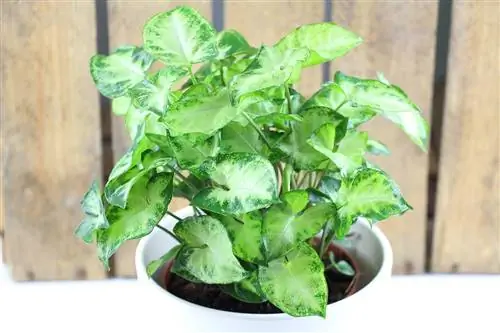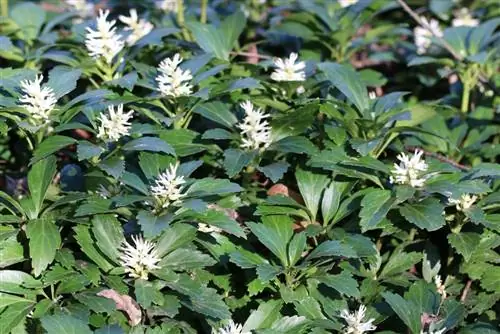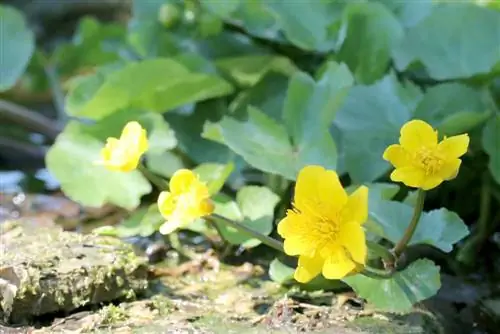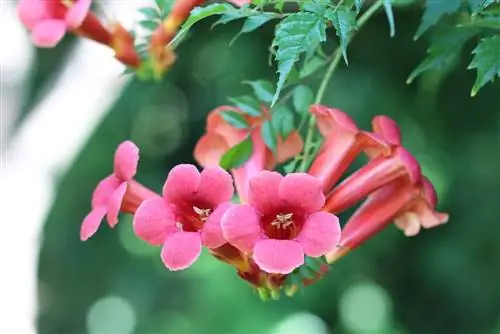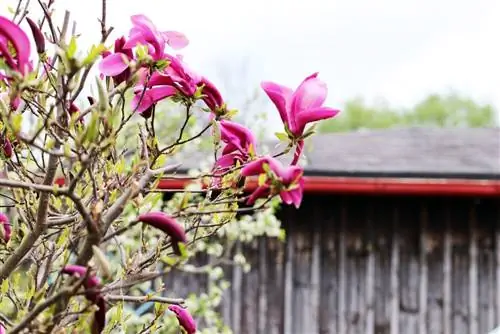- Author admin [email protected].
- Public 2023-12-17 03:39.
- Last modified 2025-01-24 12:45.
This pretty decorative foliage plant from the Araceae family is a pure houseplant and closely resembles some climbing Philodendron species. It can climb up a moss stick or hang down from a hanging basket.
Profile
- Plant family: Arum family (Araceae)
- Botanical name: Syngonium
- German name: Purpurtute
- Growth: climbing, hanging, bushy
- Growth height: 150-200 cm high or long
- Leaves: cut in the shape of an arrow, changes with age
- Foliage color: green, reddish, multicolored
- Flowers: spike-shaped, green-white, rather rare
- Lime compatibility: lime-tolerant to lime-sensitive
- Toxicity: poisonous
Location
The optimal location depends on the respective variety and the color of the leaves. The more bright parts they have, the brighter the location should be, although even the brightest variety cannot tolerate intense sunlight in a south-facing window, for example.
- White components in places that are too dark are significantly less or disappear completely
- purely green varieties can be a little darker
- Room temperatures ideally between 15 and 20 degrees
- do not significantly exceed or fall below it for a long period of time
- During the summer months, bright to partially shaded outdoor space
- can tolerate some sun in the morning and evening
Tip:
Extremely high or low temperatures as well as large temperature fluctuations can lead to heat or cold stress.
Pay attention to humidity
High humidity plays an important role, especially during the heating season. In the cold season, the air humidity in heated indoor spaces drops significantly. If temperatures exceed 18 degrees, you should take measures to increase the humidity. You can do this by regularly spraying the plants with lukewarm, low-lime or lime-free water or by placing bowls filled with water in the room. Outside the heating season, the natural air humidity in living spaces is usually sufficient.
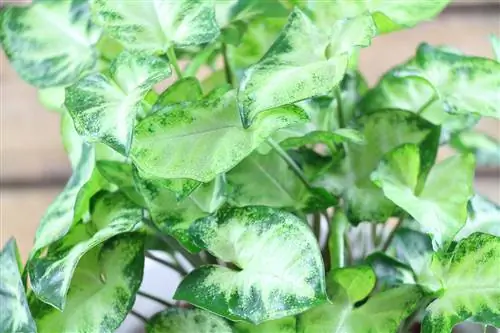
Soil texture
The pH value, which is usually indicated on the packaging, should be between 6.0 and 6.0. If it is higher or lower, the purple tute may not develop optimally. Normal potting soil from garden shops is usually only suitable to a limited extent. These substrates often lack buffering power and storage capacity. Much better is five parts high-quality potting soil, mixed with two parts clay-containing field soil and one part perlite, quartz sand or lava granules.
Pouring
This plant is a bit peculiar when it comes to water supply. It can neither tolerate too much water nor waterlogging nor a dry ball. It is therefore important to adapt watering behavior to the needs of the plants.
- Allow the top substrate layer to dry before each watering
- to a depth of about two centimeters
- Use finger test to check soil moisture
- water about once a week
- water so much that the bale is saturated with water
After about 20 minutes, remove excess water that has collected in saucers or planters to avoid stagnant moisture. The purple tute also places demands on the irrigation water. It should not be too cold and, above all, be lime-free, low in lime or at least well stale. Ideally, you only use rainwater.
Fertilize
The nutrient requirements of the Purple Tute (Syngonium) are not particularly high. In the first year after planting or repotting, fertilizer can usually be avoided completely. Fertilization can begin the following year as soon as new growth appears in spring. During the main growing season or from spring to autumn, a commercially available, low-dose liquid fertilizer is administered approximately every two weeks.
Cutting
Pruning is hardly necessary for this plant. It may only make sense to use scissors if the shoots of the Purple Tute have become too long. As a rule, the shoots can be shortened to any length. The best time for this is in spring. What you definitely shouldn't cut off are the aerial roots that these plants form. If they bother you, you can carefully guide them into the pot or substrate so that the plant can absorb additional nutrients. The clippings can be used very well to propagate the plant.
Tip:
When handling this plant, you should take into account that it is poisonous to humans and animals. Both stems and leaves are poisonous if consumed.
Wintering
This climbing plant does not go into real hibernation and can therefore hibernate all year round at room temperature. However, it can also cope with slightly cooler temperatures during the cold season. The ideal wintering temperature is 16-18 degrees. However, it should not fall below ten degrees for a longer period of time. There is no fertilization in winter and less watering. If it is rather warm, you need to water a little more, definitely enough so that the substrate does not dry out.
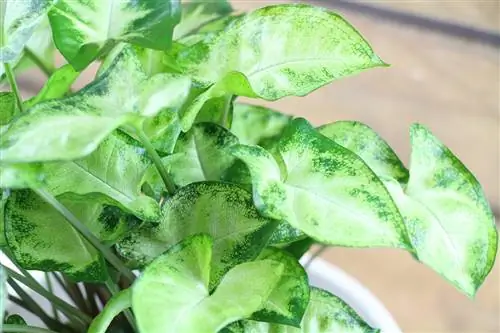
Repotting
The Purple Tute (Syngonium) grows quite vigorously, so it will soon become too cramped in the pot. For this reason, they should be transplanted into fresh substrate and a larger pot at regular intervals.
- repot about every one to two years
- new pot just a little bigger than the old one
- more wide than high
- Diameter of 12-15 cm is usually sufficient
- at traffic lights about 15-20 cm
- Substrate mixture of coarse leaf mold and compost in equal parts
- Carefully remove the plant from the old pot
- shake off old and loose soil
- Drainage from gravel or pottery shards into the new pot
- Loose the roots with your fingers
- Place the plant in the middle, don't forget to water
Tip:
When transplanting, you should use a small climbing aid such as B. use a moss stick. Otherwise the purple tute will climb over the ground.
Propagate via cuttings/offshoots
This climbing plant can be propagated via cuttings from late spring to summer. You need small pots or a mini greenhouse, growing substrate and appropriate cuttings.
- First cut cuttings about 10-15 cm long
- cut directly below a leaf node
- Leaf nodes are thickenings on the shoots
- remove the lower leaves
- Fill pots with potting soil
- insert one cutting per pot
- Moisten the substrate and keep it evenly moist
- Cover cuttings with cling film
- place in a bright, 22 to 25 degree warm place
- Remove the foil after rooting is complete
The leaf nodes usually already have roots that make root formation easier. It takes around four to six weeks for sufficient roots to form. After about six months, the young plants can be repotted individually or in small groups into pots with fresh substrate.
Tip:
Purple Tute cuttings can also be rooted very well in hydroponics and cultivated permanently.
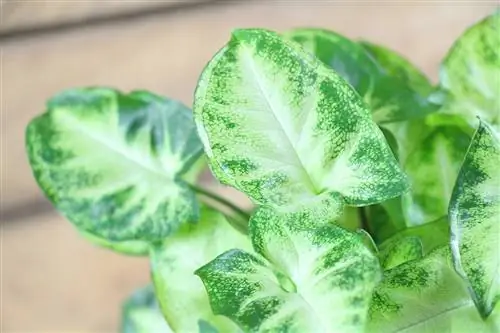
Diseases
Root rot
Root rot is usually due to incorrect watering behavior. If the plant is already severely damaged, it usually cannot be saved. In some cases, you can prevent the worst by repotting the affected plant in fresh soil as quickly as possible and refraining from watering it initially. Of course, all rotten root parts must be removed.
Pests
Spider mites
Spot-like bright spots on the leaves that continue to spread can indicate an infestation. Other symptoms include deformed shoot tips and fine white webs on the plant. Fighting it is difficult but the earlier you start, the more effective it is. First, the plant in question must be isolated. Then it is advisable to use biological preparations, which may have to be used several times.
Scale insects
Scale insects can be recognized by small brown plates on the undersides of the leaves and the bases of the leaves. Another indication of an infestation is sticky honeydew. Oil-based preparations have proven effective for combating this.
Mealybugs
An infestation with mealybugs is manifested by yellowing and curling of the leaves, honeydew and cotton-like wax secretions under which the pests sit. Spray solutions made from water, alcohol and paraffin oil as well as the use of beneficial insects such as lacewing larvae and parasitic wasps are suitable for combating them.

